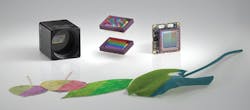Hyperspectral imaging: Vision landscape expands with the rise of hyperspectral imaging technology
Two methods used to capture images beyond the visible wavelengths include multispectral and hyperspectral imaging. Hyperspectral imaging involves narrow, usually contiguous spectral bands, involving possibly hundreds or thousands of spectra, while multispectral imaging involves spectral bands of varying bandwidths, not necessarily contiguous, but with up to 10 bands strategically selected.
Hyperspectral imaging sensors from imec
While hyperspectral imaging generally involves “push broom” imaging, in which a sensor or object is in motion, multispectral imaging typically involves single image acquisition, using specialized or custom sensors or user-defined filters. This may involve multiple image paths or moving filters.
Enabling hyperspectral imaging, imec (Leuven, Belgium; www.imec-int.com) has created off-the-shelf hyperspectral image sensors based on the CMV2000 image sensor from CMOSIS (ams Sensors Belgium, Antwerp, Belgium; www.cmosis.com), a 2.2 MPixel global shutter CMOS image sensor. These sensors are available in snapshot mosaic, snapshot tiled, line scan wedge, and line scan CCD time delay integration (TDI) formats and offer options with 4, 7, 16, 25, 32, 100+, 150+ bands.
XIMEA (Münster, Germany;www.ximea.com) offers four models based on imec sensors including line scan and snapshot mosaic sensors with 16, 25, 100+ and 150+ bands. These cameras feature a USB 3.0 interface, speeds of up to 1360 lines/sec, and spectral ranges of 470-630 nm, 470 to 900 nm, and 600-975 nm, depending on the model.XIMEA’s hyperspectral imaging cameras
“Acknowledging the popularity of combining hyperspectral or multispectral cameras with UAVs (drones) and other autonomous vehicles and robots, XIMEA is putting a lot of effort to provide the smallest hyperspectral imaging products on the market,” said Max Larin, CEO, XIMEA. “Weighing only 32g and measuring mere 26x26x31 mm, these mini cameras consume around 1W and are a perfect fit for integration into small spaces or where every gram or Watt counts.”
Photonfocus (Lachen, Switzerland; www.photonfocus.com) offers four cameras featuring imec sensors as well. Available in line scan wedge and snapshot mosaic formats, these cameras offer options with 4, 16, 25, 100, and 150 bands. Featuring a GigE interface, these cameras offer speeds up to 42 fps, and spectral ranges of 470 to 630 nm, 470 to 900 nm, 600 to 975 nm, and 600 to 1000 nm, depending on the model.
Hyperspectral image captured with Perception System
Further, imec partnered with Adimec (Eindhoven, The Netherlands; www.adimec.com) to develop a hyperspectral system based on a Quartz camera with a 2 MPixel CMOS sensor. Offering a line scan format with 150+ bands and Camera Link interface, this system features a spectral range of 470 – 900 nm and a speed of 2 KHz.
Imec has also developed its own hyperspectral products, including the SNAPSCAN NIR and SNAPSCAN VNIR systems, which offer snapshot and line scan formats with 100+ and 150+ bands, as well as 600 to 1000 nm or 470 to 900 nm spectral ranges, depending on the model.
Based on CCD-in-CMOS technology, imec’s multispectral TDI sensor argus, works by putting filters directly on top of the CMOS image sensors at wafer level. The filters can be patterned at pixel level, giving every pixel its own spectral filter, thus enabling the addition of tens to hundreds of filter bands to the top of the sensors.
Specim (Oulu, Finland; www.specim.fi) offers hyperspectral cameras that do not use imec sensors such as the FX17 model, an InGaAs-based camera with a spectral range of 900 – 1700 nm and free wavelength selection from 230 bands within the camera coverage. At full frame, the camera—which is available in GigE or Camera Link—can reach 670 fps, and with 4 bands selected, can reach 15,000 fps.
Other vendors include Headwall Photonics (Bolton, MA, USA; www.headwallphotonics.com), which develops products for remote sensing and machine vision, as well as BaySpec (San Jose, CA, USA; www.bayspec.com), which develops hyperspectral imagers for airborne, unmanned, and handheld applications.
On the processing side, the Perception System from Perception Park (Graz, Austria; www.perception-park.com) is a generic, configurable data processing solution enabling the industrial use of hyperspectral cameras. Based on “Chemical Color Imaging (CCI) technology,” the systems identify the unique “fingerprints” of objects based on their chemical and molecular properties. Featuring an Intel processor and chipset and an NVIDIA GPU, this system processes more than 1 million spectra/s and more than 200 million spectral points/s.
“CCI is usually integrated into industrial processes, most of which require real-time processing and high standards for the latency,” said Manfred Pail, CFO, Marketing and Sales, Perception Park. “To meet the requirements for the highest computing performance, strong GPUs are used, which allow parallel data processing and offer flexibility to implement new methods and algorithms at short notice.”



